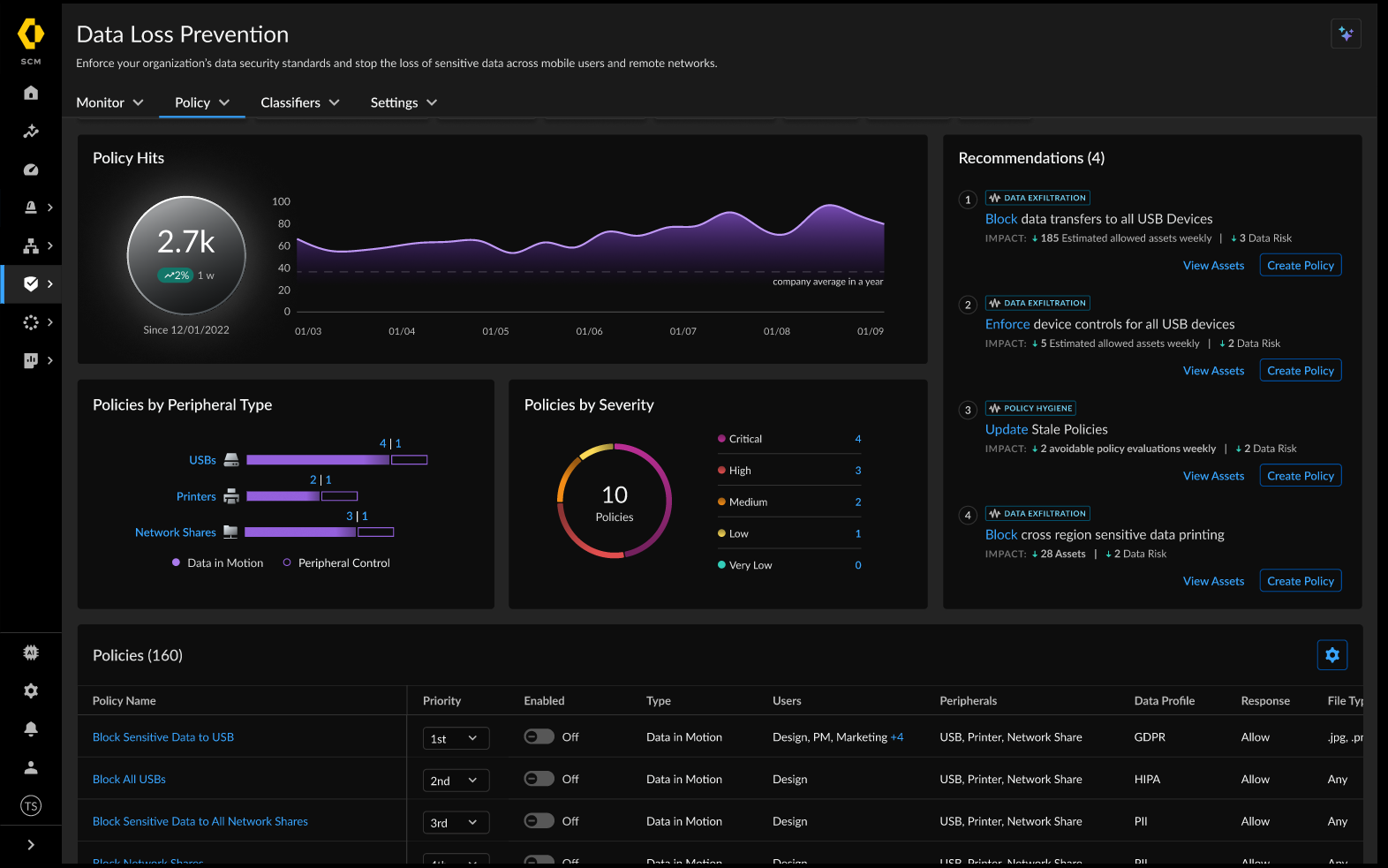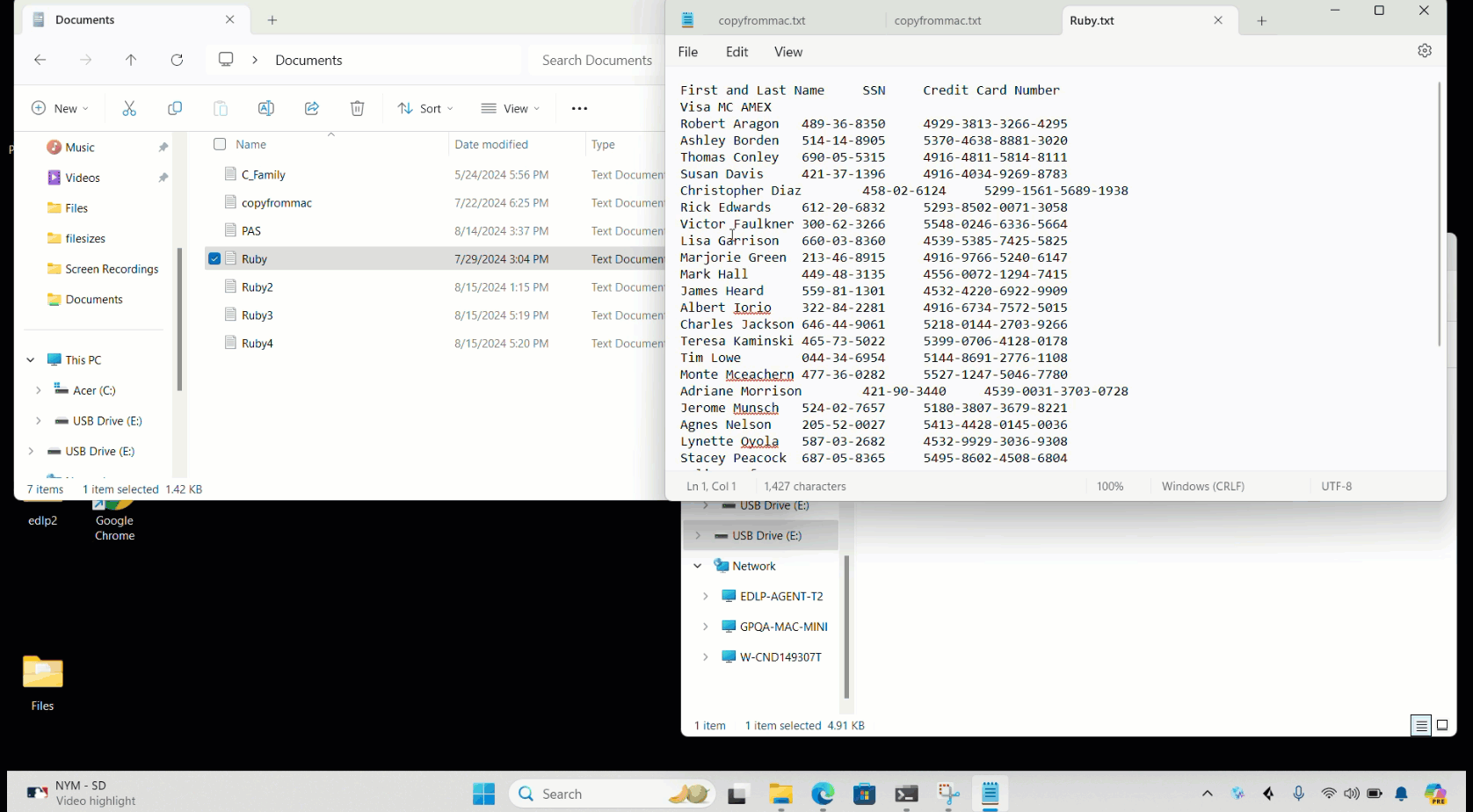In our digital world, the importance of endpoint data loss prevention (DLP) is driven by the overarching need to protect sensitive data, anywhere it travels. Organizations today seek to safeguard against data exfiltration via removable devices, manage risks posed by remote and hybrid workforces, track and audit data usage, and mitigate risk from insider threats.
For example, a disgruntled or former employee may steal sensitive information via USB drives, network shares, or by printing documents at home beyond the oversight of corporate IT security teams. Businesses face significant vulnerabilities if they fail to address sensitive data leakage via endpoints.
With the rise of hybrid work, employees outside traditional office environments have increased the risk of data loss, especially with excessive sharing, mishandling of data, and data exchanges over less-secure home networks and unmonitored network shares. The 2024 Verizon Data Breach Investigations Report revealed that more than two-thirds (68%) of breaches included a nonmalicious element or incidents that involved insider-driven data loss from human error or social engineering.
Introducing Palo Alto Networks Endpoint DLP
We’re excited to announce the availability of Palo Alto Networks Endpoint DLP, delivered through the single, unified Palo Alto Networks SASE client.
With this addition to our solution, Palo Alto Networks now delivers comprehensive data protection that seamlessly extends across your corporate networks, branch offices and remote workers, software-as-a-service (SaaS) applications, infrastructure as a service (IaaS), platform-as-a-service (PaaS) services, email traffic, browser and endpoints, ensuring that every potential avenue for data loss and theft is secured.
Powered by the same consistent detection engine across the enterprise, Palo Alto Networks Data Security ensures unified policies and data profiles, reducing complexity and total cost of ownership—all through a single cloud-delivered solution.
Reduce Risk with Granular Controls at Local Endpoint Channels
Palo Alto Networks Endpoint DLP protects sensitive data from both accidental exposure and intentional exfiltration attempts, including those through USB removable media, printers, and network shares.
While local endpoint channels can serve as useful tools for employees, they can also be used as conduits for unauthorized data transfers. With endpoint DLP, organizations can enforce content control and prevent risky movements of specific sensitive data, while allowing other flows of non-sensitive data to occur without disruption. Additionally, they can implement granular device control to restrict access to specific endpoint channels.
For example, organizations can decide to outright block all employees from using USB removable media devices except for a list of company-approved USBs. Organizations can then enable policies to prevent specific sensitive data transfers to the approved USB list. This ability ensures unauthorized data transfers are still being accounted for even for allowed USBs.
In addition to device-level controls, organizations can manage user-level exception handling—via integration with existing identity providers—to enforce policies with select users or user groups.
The content-level, device-level, and user-level granularity allows organizations to implement the most restrictive controls while minimizing impact to day-to-day business processes.

Figure 1: Palo Alto Networks Endpoint DLP dashboard with policies and recommendations*
Pinpoint Accuracy with LLM and AI-Powered Data Classification
Palo Alto Networks Endpoint DLP detects and prevents sensitive data leakage with an exceptional degree of accuracy across all channels by augmenting traditional classification with LLM-powered and context-aware AI/ML models.
These models are trained on diverse corpora of data encompassing a wide range of languages to interpret semantics with contextual understanding for near-perfect accuracy. The cloud DLP engine also leverages a wide range of advanced data detection techniques—such as exact data matching (EDM), indexed document matching (IDM), and optical character recognition (OCR), among others—to further minimize false positives.
All these advanced data detection capabilities are delivered in an easy-to-use manner with a comprehensive set of predefined categories and the ability to define custom categories tailored to your organization.
Let’s see this in action. For example, a given enterprise may allow all employees to print documents in the office but decide to restrict printing of sensitive documents to only select users. Palo Alto Networks Endpoint DLP can block printing based on the user and the sensitivity of the data detected within the document.

Figure 2: Endpoint DLP end-user experience.
Coach Users When Un/Intentional Policy Violations Occur
Palo Alto Networks Endpoint DLP reduces data security violations over time and enhances the user experience, thanks to end-user coaching. These dynamic, customizable and real-time toast notifications allow you to educate employees on policy violations and noncompliant behavior, reduce the frequency of repeat offenders, and build exemption and justification workflows to ensure legitimate data exchanges are unaffected.
Employees can gain a better understanding of company policies and learn to proactively reduce the risk of inadvertent data loss. This, in turn reduces the burden on support teams when addressing user-raised issues as they occur.
A SASE-Native Endpoint DLP Solution
This release positions Palo Alto Networks as a leading data security vendor with a holistic solution that stands out as a strong alternative to legacy DLP deployments that are fraught with complexity.
What makes Palo Alto Networks stand out:
- One centralized cloud-based data security service: Traditional DLP platforms often require managing multiple services—one for each control point—leading to fragmented consoles, duplicated policies, and manual replication every time a new channel is added. This increases complexity and consumes valuable time for information security teams.Palo Alto Networks simplifies this by ensuring consistent data classification rules and policies across all channels, eliminating the need for manual duplication and reducing the operational burden of managing disparate consoles and systems.
- Single, unified SASE agent: There’s no need to manage a separate endpoint agent solely for DLP anymore. The Palo Alto Networks SASE client now integrates Endpoint DLP into a single lightweight client, simplifying the management and maintenance of multiple agents typically required by traditional approaches.The unified Palo Alto Networks SASE client delivers all security capabilities—including data protection—in one streamlined, lightweight solution.
- Overcomes traditional compute limitations: Traditional endpoint DLP is typically a compromised version of a full DLP, unable to run resource-intensive detections—such as EDM, document fingerprinting and OCR—without degrading endpoint performance.Palo Alto Networks addresses this challenge by leveraging the cloud for resource-intensive tasks, delivering the same robust detections (including advanced AI/ML-based data classifications) across the entire solution, including endpoints.
Endpoint DLP as Part of a Holistic Data Security Strategy
Incorporating Endpoint DLP into your holistic data security strategy is critical for safeguarding sensitive information across all endpoints, and beyond. By extending control to endpoints, organizations can further mitigate the risks of data exfiltration, detect insider threats, and adapt to the demands of remote and hybrid work environments. With real-time protection and unified policies powered by a consistent detection engine, Palo Alto Networks provides the most comprehensive coverage across all data loss vectors—including network, email, SaaS, IaaS, browsers, GenAI applications, and now, endpoints.
As part of a cloud-delivered solution, our approach reduces complexity and lowers the total cost of ownership, allowing organizations to streamline security management.
Contact your representative to explore how our integrated data security solution can empower your business to thrive in today’s dynamic digital landscape. Together, we’ll shape the future of data security and enable you to stay ahead of emerging threats.
This blog contains forward-looking statements that involve risks, uncertainties and assumptions, including, without limitation, statements regarding the benefits, impact or performance or potential benefits, impact or performance of our products and technologies. These forward-looking statements are not guarantees of future performance, and there are a significant number of factors that could cause actual results to differ materially from statements made in this blog. We identify certain important risks and uncertainties that could affect our results and performance in our most recent Annual Report on Form 10-K, our most recent Quarterly Report on Form 10-Q, and our other filings with the U.S. Securities and Exchange Commission from time-to-time, each of which are available on our website at investors.paloaltonetworks.com and on the SEC's website at www.sec.gov. All forward-looking statements in this blog are based on information available to us as of the date hereof, and we do not assume any obligation to update the forward-looking statements provided to reflect events that occur or circumstances that exist after the date on which they were made.
*This dashboard view will be available with an upcoming release.